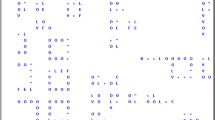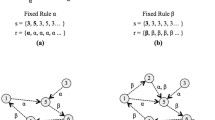Abstract
This paper presents a novel model of artificial biological time series generation. We employed a cellular automata (CA) system that comprises self-replicating and mutually competing loops. Our self-replicating system is an advanced version of Chou & Reggia’s system (Physica D 110, 252–276). The complex self-replicating CA loops were developed using a construction scheme in which we introduce a unique measure of the CA to quantify the activity of the loops. By summing the loop activities globally and observing the time evolution of the sum, we obtain an artificial time series. The power spectrum of the resulting time series exhibits \({1 \mathord{\left/ {\vphantom {1 {f^{\alpha } }}} \right. \kern-\nulldelimiterspace} {f^{\alpha } }}\) scaling behavior. The exponent \(\alpha\) in the \({1 \mathord{\left/ {\vphantom {1 {f^{\alpha } }}} \right. \kern-\nulldelimiterspace} {f^{\alpha } }}\) power spectrum of the unconstrained self-replicating system is \(\alpha \approx 1.5\). Constraints on loop dynamics, leading to larger-scale death in the loop colonies, are implemented in our CA. With the application of the constraints, the value of \(\alpha\) is lowered to nearly 1. The results show that self-replication and death in the CA space play the roles of excitatory and inhibitory synaptic functions, respectively, in a neuronal network. The self-replication/death balance control in our study could modulate the scaling exponent \(\alpha\) in the power spectrum, similar to the activation/inhibition balance control in neural networks and local field potential (LFP) simulations in recent studies. The calculation of the largest Lyapunov exponent, L1, shows the chaotic nature of the time series. The form of our CA system resembles that of neuronal potential transmission and replication to nearby neurons. The results of this study suggest another feasible concept for the origin of biological signals. Executable codes associated with this study are freely accessible.











Similar content being viewed by others
References
P. Bak, C. Tang, K. Wiesenfeld, Phys. Rev. Lett. 59, 381 (1987)
P. Dutta, P.M. Horn, Rev. Mod. Phys. 53, 497 (1981)
A. Amir, Y. Oreg, Y. Imry, Proc. Natl. Acad. Sci. 109, 1850 (2011)
E.W. Montroll, M.F. Schlesinger, Proc. Natl. Acad. Sci. USA 79, 3380 (1982)
T. Geisel, A. Zacherl, G. Radons, Phys. Rev. Lett. 59, 2503 (1987)
A. Ben-Mizrachi, I. Procaccia, N. Rosenberg, A. Schmidt, H.G. Schuster, Phys. Rev. A 31, 1830 (1985)
B. Kaulakys, V. Gontis, M. Alaburda, Phys. Rev. E 71, 051105 (2005)
A.A. Ali, Phys. Rev. E 52, R4595(R) (1995)
S. Maslov, C. Tang, Y.C. Zhang, Phys. Rev. Lett. 83, 2449 (1999)
P. De Los Rios, Y.C. Zhang, Phys. Rev. Lett. 82, 472 (1999)
J. Davidsen, M. Paczuski, Phys. Rev. E 66, 050101(R) (2002)
L. Laurson, M.J. Alava, S. Zapperi, J. Stat. Mech. (2005). https://doi.org/10.1088/1742-5468/2005/11/L11001
D. Dhar, Phys. A 369, 29 (2006)
A.C. Yadav, R. Ramaswamy, D. Dhar, Phys. Rev. E. 85, 061114 (2012)
G. Grinstein, T. Hwa, H.J. Jeldtoft Jensen, Phys. Rev. A 45, R559(R) (1992)
G.W. Wornell, Proc. IEEE 81, 1428 (1993)
N.J. Arnold, G. Wade, Electron. Lett. 27, 1169 (1991)
H.J. Jensen, K. Christensen, H.C. Fogedby, Phys. Rev. B 40, 7425 (1989)
V. Frette, K. Christinasen, A. Malthe-Sørenssen, J. Feder, T. Jøssang, P. Meaken, Nature 379, 49 (1996)
J.M. Halley, Trends Ecol. Evol. 11, 33 (1996)
J.H. Steele, Nature 313, 355 (1985)
S.L. Pimm, A. Redfearn, Nature 334, 613 (1988)
C.T. Kello, G.D. Brown, R. Ferrer-I-Cancho, J.G. Holden, K. Linkenkaer-Hansen, T. Rhodes, G.C. Van Orden, Trends Cogn. Sci. 14, 223 (2010)
B. Voytek, M.A. Kramer, J. Case, K.Q. Lepage, Z.R. Tempesta, R.T. Knight, A. Gazzaley, J. Neurosci. 35, 13257 (2015)
E. Novikov, A. Novikov, D. Shannahoff-Khalsa, B. Schwartz, J. Wright, Phys. Rev. E. 56, R2387 (1997)
L.M. Ward, Dynamical Cognitive Science (MIT Press, Cambridge MA, 2002)
W.J. Freeman, L.J. Rogers, M.D. Holmes, D.L. Silbergeld, J. Neurosci. Meth. 95, 111 (2000)
K. Linkenkaer-Hansen, V.V. Nikouline, J.M. Palva, R.J. Ilmoniemi, J. Neurosci. 21, 1370 (2001)
W.J. Freeman, Clin. Neurophysiol. 117, 572 (2006)
H.R. Kim, H. Go, S. Kim, J. Korean Phys. Soc. 73, 377 (2018)
H.R. Kim, S. Kim, S. Park, J. Korean Phys. Soc. 34, 390 (1999)
D. Kim, J. Jeong, K. Kim, J. Chae, S. Jin, K. Ahn, H. Myrick, S. Yoon, H.R. Kim, S. Kim, Alcohol. Clin. Exp. Res. 27, 1955 (2006)
H.R. Kim, K. Jung, S. Kim, K. Ko, Y. Lee, J. Kim, Early Hum. Dev. 75, 35 (2003)
H.R. Kim, C. Guilleminault, S. Hong, D. Kim, S. Kim, H. Go, S. Lee, J. Sleep Res. 10, 193 (2001)
H.R. Kim, H. Kim, S. Kim, H. Go, D. Kim, Biol. Cybern. 85, 1 (2001)
H.R. Kim, S. Kim, D. Kim, Y. Kim, S. Park, J. Chae, K. Kim, K. Lee, S. Lee, Am. J. Chinese. Med. 29, 23 (2001)
B.F. Apostol, Phys. Lett. A 351, 175 (2006)
B.F. Apostol, L.C. Cune, M. Apostol, Rom. J. Phys. 53, 593 (2008)
F. Omori, J. Coll. Sci. Imper. Univ. Tokyo 7, 111 (1894)
H.R. Kim, D. Kihara, Proteins 82, 3255 (2014)
H.R. Kim, D. Kihara, Proteins 84, 105 (2016)
L.X. Peterson, H.R. Kim, J. Esquivel-Rodriguez, A. Roy, X. Han, W. Shin, J. Zhang, G. Terashi, M. Lee, D. Kihara, Proteins 85, 513 (2017)
B. Alberts, A. Johnson, J. Lewis, M. Raff, K. Roberts, P. Walter, Molecular Biology of the Cell (Garland Science, New York, 2002)
J. Von Neumann, Theory of Self-Reproducing Automata (University of Illinois Press, Urbana, 1996)
W. Stallings, L. William, Computer Security: Principles and Practice (Pearson, Boston, 2012)
M. Komosinski, A. Adamatzky, Artificial Life Models in Software (Springer, New York, 2009)
E. Moulin, N. Giuseppone, Constitutional Dynamic Chemistry (Springer, Berlin, 2011)
R.A. Freitas, R.C. Merkle, Kinematic Self-Replicating Machines (Landes Bioscience, Georgetown, 2004)
G. Von Tiesenhausen, W.A. Darbro, Self-Replicating Systems: A system engineering approach, in NASA Technical Memorandum 78304 (Washington D.C., 1980)
T. Wang, R. Sha, R. Dreyfus, M.E. Leunissen, C. Maass, D.J. Pine, P.M. Chaikin, N.C. Seeman, Nature 478, 225 (2011)
E.V. Koonin, T.G. Senkevich, V.V. Dolja, Biol. Direct 1, 29 (2006)
Y.E. Karapetyan, Proc. Natl. Acad. Sci. USA 109, E461 (2012)
J. Masel, V.A. Jansen, M.A. Nowak, Biophys. Chem. 77, 139 (1999)
M. Gardner, Sci. Am. 223, 120 (1970)
S. Ninagawa, M. Yoneda, S. Hirose, Physica D 118, 49 (1988)
M. Andrecut, Mod. Phys. Lett. B 14, 53 (2000)
E.F. Codd, Cellular Automata (Academc Press, New York, 1968)
C.G. Langton, Physica D 10, 135 (1984)
H.H. Chou, J.A. Reggia, Physica D 110, 252 (1997)
M. Sipper, Artif. Life 4, 237 (1998)
E.F. Moore, Sci. Am. 195, 118 (1956)
G. Buzsáki, C.A. Anastassiou, C. Koch, Nat. Rev. Neurosci. 13, 407 (2012)
M.B. Kennel, R. Brown, H.D.I. Abarbanel, Phys. Rev. A 45, 3403 (1992)
J. Jeong, S.Y. Kim, S.H. Han, Electroen. Clin. Neuro. 106, 220 (1998)
A. Wolf, J.B. Swift, H.L. Swinney, J.A. Vastano, Physica D 16, 285 (1985)
D. Mange, A. Stauffer, E. Petraglio, G. Tempesti, Physica D 191, 178 (2004)
van Vreeswijk, H. Sompolinsky, Science 274, 1724 (1996)
B. Haider, A. Duque, A.R. Hasenstaub, D.A. McCormick, J. Neurosci. 26, 4535 (2006)
F. Lombardi, H.J. Herrmann, L. de Arcangelis, Chaos 27, 047402 (2017)
R. Gao, E.J. Peterson, B. Voytek, Neuroimage 158, 70 (2017)
R.M. May, Proc. R. Soc. Lond. A 413, 27 (1987)
J.S. Isaacson, M. Scanziani, Neuron 72, 231 (2011)
E. Ott, Chaos in Dynamical Systems (Cambridge University Press, New York, 1993)
T.M. Sales, J.B.C. Garcia, T.I. Jyh, T.I. Ren, M.A.F. Gomes, Phys. A 197, 604 (1993)
V. Medel, M. Irani, T. Ossandón, G. Boncompte, bioRxiv (2020). https://doi.org/10.1101/2020.09.15.298497
Acknowledgements
This work passed the internal review of MPI-PKS and was archived in the MPG edoc server (https://web.archive.org/web/20200609112257/http://edoc.mpg.de/330829). This study was presented in the 2020 KPS fall meeting as P1-bp.001. The work was supported by the 2020 Hannam University Research Fund. Any questions and executable code requests are welcomed by the author (hr_kim@hnu.kr; k52hr01@gmail.com)
Author information
Authors and Affiliations
Corresponding author
Additional information
Publisher's Note
Springer Nature remains neutral with regard to jurisdictional claims in published maps and institutional affiliations.
Supplementary Information
Below is the link to the electronic supplementary material.
Rights and permissions
About this article
Cite this article
Kim, HR. A model of artificial biological time series generation. J. Korean Phys. Soc. 79, 412–427 (2021). https://doi.org/10.1007/s40042-021-00259-z
Received:
Revised:
Accepted:
Published:
Issue Date:
DOI: https://doi.org/10.1007/s40042-021-00259-z




